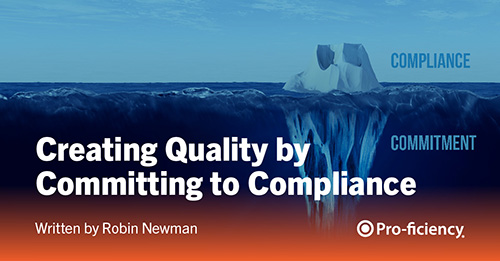Creating Quality by Committing to Compliance in Clinical Research
In the highly regulated world of clinical research, compliance is an ongoing concern, but can be viewed as an annoying and costly item to check off a regulatory to-do list. And it can cost a great deal of money, not to mention valuable staff time, to be compliant, especially at the front end of a study.
But establishing systems to ensure compliance up front can pay off in spades, primarily by removing most of the “noise”—glitches in operational systems that can make it difficult to quickly and easily determine whether there is a problem with an investigational product or if the problem stems from a systemic issue.
At its most basic, compliance is adherence to a set of standards or regulations. In the clinical research arena, compliance involves, broadly, performance standards and safety standards, for instance. Compliance with applicable standards and regulations is necessary to create a minimally viable product.
Clinical research involves multiple parties, each with their own particular compliance responsibilities. For instance, drug and device sponsors must make investigational products in accordance with GMPs/QSR requirements, respectively, as well as meet regulatory requirements for submitting information generated during a study.
At the research site level, IRBs lay out guidelines and standards within their own communities of research sites. Sites also must adhere to strict ethical standards, requirements for specific grant-funded efforts and internal policies.
By complying with all such requirements, clinical trials are better able to ensure that they perform optimally, meet defined endpoints and deliver the investigative treatment in a safe manner, while ensuring patient safety.
Compliance vs quality
It’s impossible to discuss compliance without also considering quality; regulations and performance standards are intended, after all, to ensure a good quality product. But while the two concepts are linked, they are not the same.
Quality involves factors such as useability, durability, utility, affordability, accessibility and other things that influence how a product is experienced by the users. It’s possible to build a compliant product that is not of good quality. But without compliance. When it comes to clinical research, the notion of quality revolves around the patient experience.
Compliance focuses on adherence to regulations and standards. Because those regulations and standards generally are written with the goal of product quality in mind, it’s harder to achieve important quality-related factors like reproducibility and consistency, without compliance.
It is, however, possible for a product or clinical trial to be compliant and still yield a poor-quality product or inadequate research in terms of those factors. This is usually due to a checklist approach to compliance.
Many in the industry tend to view compliance activities in that way, as an onerous task involving a lot of fussy checklists, paper work and documentation. In reality, compliance needs to focus on high-reliability systems that can meet all safety and other basic requirements, including patient needs.
Without systems in place to ensure compliance with all pertinent regulations and standards, problems can occur during the trial that ultimately are more costly. These systems can include SOPs, templates, work aids and other tools that help researchers perform consistently both throughout an individual study and across multiple studies.
Noncompliance comes with costs
Noncompliance during a clinical trial can cause regulatory problems that up the cost of a clinical trial, as well as pose risks to patients and affect data quality. The time required to complete a clinical trial can be extended significantly in the face of noncompliance, whether that is regulatory, protocol deviations or amendments or other problems.
Failure to meet all regulatory requirements can delay time to new product approval. This applies to IRB requirements and other standards, as well. Addressing such problems—including finding the root cause—can add time and expense to a study.
More than that, not all costs can be measured only in dollars and cents. Noncompliance can damage a company’s or research site’s reputation. And the ultimate cost of not following the rules in the medical field is risk to patient health and safety.
The cost of redoing something is always higher. This refers not only to money, but also to patient outcomes, regulatory or legal sanctions and corporate reputation. One of the goals of compliance should be to establish systems that allow early, accurate detection of problems, before harm comes to patients or data integrity cannot be assured.
Cutting through systemic ‘noise’
But a clinical trial built on a foundation of scrupulous compliance with all applicable regulations, policies and standards will fare much better when unexpected problems arise. Compliant systems will have redundancies and failsafes built in to help weather any disasters that may befall a study.
One of the most important things good compliance systems provide is the ability to see when something isn’t right. If aberrant data is quickly visible, it can be addressed before serious risks to patient safety and data integrity develop.
For example, a device manufacturer that produces a stent on a limited, one-by-one basis will find it extraordinarily difficult to conduct that manufacturing within a quality system. In this sort of a system, QSR compliance and consistent manufacturing quality would be challenging. Such a company wouldn’t have anything to look back on within its compliance system to understand where the point of failure was when the inevitable problems cropped up; it would be difficult to determine if a device failure was due to an issue with the product itself or to problems in the manufacturing system.
A more systematic method of production, in compliance with the QSR, on the other hand, adds traceability into the design. And this helps clear out the extraneous noise so that any problems that occur are more likely to be completely separate from the systems.
And the ability to handle problems can be crucial during a clinical trial. For instance, many medical devices perform essential functions that affect a patient’s immediate health. If an investigational device fails, things can go south quickly and dramatically for patients. Even in areas like medical scanning or imaging, failures can mean inaccurate diagnoses and treatment paths for patients.
Under compliance systems like this, if something comes up that is wrong, it is very apparent. Without clear systems, it’s harder to see when something has gone wrong.
For example, systematic collection of data on the front end helps researchers to see aberrant or outlying data points quickly. When a problem originates in the investigational product itself, systematic deviations will appear within the compliant systems. In other words, any deviations in data can be assumed to be because of an issue with the product.
In this way, a focus on compliance can eliminate extraneous “noise” within the clinical trial system. When all the compliance underpinnings are in place, systems within the trial will work in a consistent, reliable manner. With these basics handled up-front, researchers and sponsors are then free to be more creative and more agile in responding to new challenges or needs.
Research staff must be trained to work within the established compliance systems, as well as to perform the study protocol correctly. Since different people learn in different ways, it’s important that training incorporate different senses. Simulation-based approaches, like that offered by Pro-ficiency, often do the best job of incorporating multiple learning styles while also allowing the opportunity to practice in a consequence-free environment.
Pro-ficiency’s protocol analysis and training approaches, for instance, help take the noise out of the system by helping research staff understand clearly what has to happen and how it has to happen.
In short, a focus on compliance from a systems approach means that researchers don’t have to think about every tiny step that is taken for every procedure or task required in a given protocol. They can, instead, focus on the central focus of the study, which must always be patient care and data quality and integrity.

Robin Newman, MSN EdD CPNP, is the Global VP for Clinical Affairs at Beckman Coulter Diagnostics and Life Sciences. With a nursing education from the University of Texas at Austin and Arlington, she also holds a doctorate in Human & Organizational Learning and Development from The George Washington University. With over 25 years of experience, Dr. Newman has dedicated her career to developing healthcare solutions in the medical device and biopharmaceutical industries. Her extensive background includes leadership roles at Johnson & Johnson, the US Food & Drug Administration, Siemens Healthcare Diagnostics, and as the Founder and CSO of MedTrials, a Dallas-based clinical research and regulatory consulting firm.


